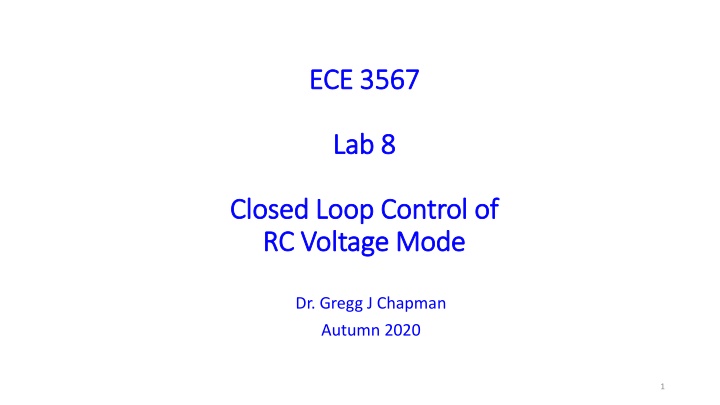
Analog-to-Digital Converters in Electronic Control Systems
Delve into the world of analog-to-digital converters (ADCs) for electronic control systems, exploring various types such as Flash, Ramp, Delta-Sigma, and more. Learn about their functionalities, advantages, and applications in the realm of voltage mode control. Discover the nuances of successive approximation register converters and the principles behind SAR converters for optimum resolution and speed in ADC performance.
Download Presentation

Please find below an Image/Link to download the presentation.
The content on the website is provided AS IS for your information and personal use only. It may not be sold, licensed, or shared on other websites without obtaining consent from the author. If you encounter any issues during the download, it is possible that the publisher has removed the file from their server.
You are allowed to download the files provided on this website for personal or commercial use, subject to the condition that they are used lawfully. All files are the property of their respective owners.
The content on the website is provided AS IS for your information and personal use only. It may not be sold, licensed, or shared on other websites without obtaining consent from the author.
E N D
Presentation Transcript
ECE 3567 ECE 3567 Lab 8 Lab 8 Closed Loop Control of Closed Loop Control of RC Voltage Mode RC Voltage Mode Dr. Gregg J Chapman Autumn 2020 1
Analog Analog- -to to- -Digital Converters Digital Converters Successive Approximation Register Successive Approximation Register 2
Analog Analog- -to to- -Digital Converters Digital Converters 1. Parallel (or Flash) Converter 2. Ramp Converter 3. Delta-Sigma (or Sigma-Delta) Converter 4. Successive Approximation Register Converter 3
Flash Converter Flash Converter Fastest ADC Hardware Intensive High cost. Power hungry. A 16-bit Flash ADC has 216 65,536 comparators. Signal to Noise is a huge issue for resolution
Ramp Converter Ramp Converter Slowest ADC Best Resolution
- - Converter Converter Best noise rejection No analog anti-aliasing filters needed - Modulator converts analog voltage to a PWM bit stream
- - Modulator Modulator
- - Converter Converter ADC Process PWM Bit-stream Digitized Values - Modulator converts analog voltage to a PWM bit-stream Digitized Waveform A-to-D counts the number of high values at a fixed clock rate, for a fixed duration of time Clock rate effectively OVERSAMPLES the signal. eliminating the need for anti-aliasing filters. Decimation is a Digital Low Pass Filter. Signal to Noise is the best of all ADCs
SAR Converter SAR Converter Best compromise Resolution better than Flash Converter Speed better than Ramp or - Converter
ADC ADC Comparison Comparison
RC Voltage Feedback RC Voltage Feedback MCU RC_SetPoint SW Comparison & Feedback LP RC Filter ADCValue1 RC Filtered Voltage A5 ADC Duty Cycle PWM5 TB0CCR5 Step Size and Polarity
Compared to SAR Compared to SAR TB0CCR5
Low vs. High SetPoint Low vs. High SetPoint Volts Volts 3.25 3.25 3.00 3.00 2.75 2.75 2.50 2.50 2.25 2.25 2.00 2.00 1.75 1.75 1.50 1.50 1.25 1.25 1.00 1.00 0.75 0.75 0.50 0.50 0.25 0.25 0.00 0.00 0 1 2 3 4 5 0 1 2 3 4 5 iteration # iteration #
Reasoning for initialization in the RE and RS Commands: The RE instruction should be set the initial voltage to 1.65 volts, exactly half of 3.30 volts to minimize the initial voltage change. The beginning of the feedback algorithm should be included in the RS command and: This means that the filtered voltage will always begin at 1.65 volts as the first step in successive approximation after an RSxxx command is issued. Re-initialize the duty cycle (TB0CCR5) to init_duty_cycle (0x00A4, 1.65 volts). step to max_step_size (0x0052). Note that this is one of the maximum duty cycle range. For the fastest convergence use the same approach as the Successive Approximation Register: If the RC_SetPoint is greater than volts, add the step If the RC_ SetPoint is less than volts, subtract the step Each iteration, reduce the step size to of the current value, UNTIL you reach a step size of 1.
RC Voltage Setpoint Command (New) From ECE3567.h
Closed Loop Control of RC Voltage WARNING! Most variables are unsigned int. DO not use ABS() and be VERY careful of using subtraction since negative numbers are NOT permitted.
A Demonstration of Proper Operation
Checkpoints 1) The RE Command results in a stable 1.65V output on the LED Display, and the LED remains Green (MOST of the time). 2) The RS Command is parse correctly, and the RC Voltage controller converges 3) The controller converges to all set point values between 0.25 volts and 3.25 volts in 9 iterations or less. 4) The controller keeps the output voltage within the GREEN LED range, once the algorithm has converged.
